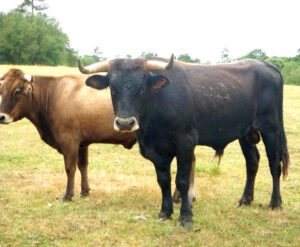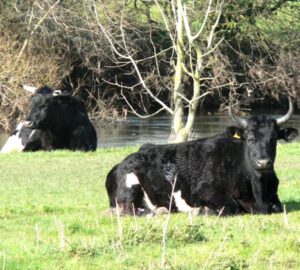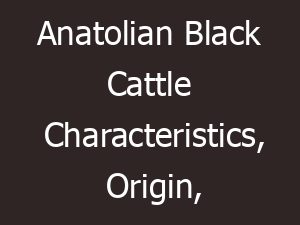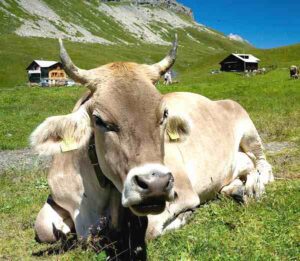The Afrikaner cattle are a breed of beef cattle indigenous to South Africa. It is also known as the Africander and it is mainly raised for meat production.
Huge herds of this type of cattle were herded by the Khoikhoi when the Dutch established the Cape Colony in 1652. Ancestors of the breed are believed to originated on the Asian Steppes, before migrating into Africa about 2000 years ago.
The cattle population also gradually moved southwards through the continent. The Afrikaner cattle are a very old breed of cattle. They share coancestry with the Nguni and Drakensberger cattle breeds, and they most likely diverged 655-960 years ago.
Total population of the breed became very less, and they almost became extinct in the early 20th century. The first Afrikaner studbook was formed in 1912 in South Africa in order to control the breed’s development.
Although a high degree of inbreeding occurred at present time mainly due to the recently depleted numbers of this animals. Until the 1970s, the Afrikaner cattle were the most abundant breed of cattle in South Africa.
But their popularity decreased among the local farmers due to the problems associated with lowered fertility, inbreeding and decreased reproductive period in the cows.
Other reasons for decreasing their population include crossbreeding with exotic cattle breeds and also the introduction of the Brahman cattle to southern Africa.
Currently the breed is distributed mainly in South Africa, and also available in Australia and Zimbabwe. Read more information about the breed below.
Afrikaner Cattle Characteristics
The Afrikaner cattle breed is a medium to large animal usually with deep red color. It is well muscled with long legs and shallow body. It has the small cervices-thoracic hump, which is typically of Sanga cattle type.
Both bulls and cows have horns. Their horns are long and lateral which turn upwards. But their horns are often polled in commercial operations.
Legs of the Afrikaner cattle are slightly sickle shaped. Height of both bulls and cows is around 152 cm, but the bulls are pretty larger than the cows.
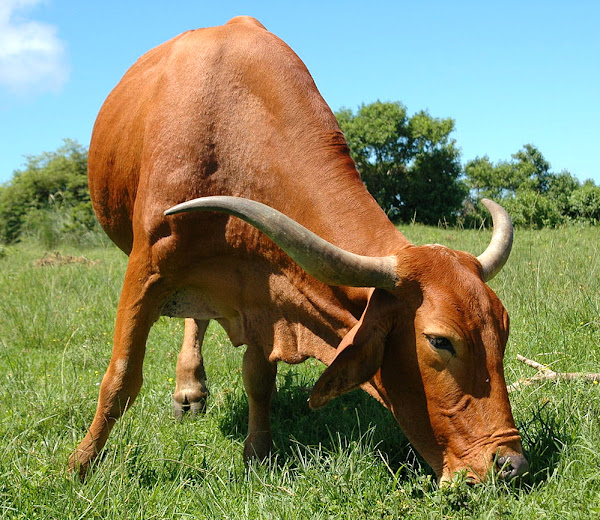
Average live body weight of the mature cows is between 450 and 600 kg. And live body weight of the mature bulls vary from 820 to 1090 kg. Photo and info from Wikipedia.
Uses
The Khoikhoi used the Afrikaner cattle for both milk and meat production. They were also used mainly as a draught animal after European settlement. But today they are raised mainly as a beef cattle breed for meat production.
Special Notes
The Afrikaner cattle are very hardy animals, and they are well adapted to their local hot, arid conditions. Their skin contains twice as many sweat pores as the European cattle breeds.
They have very good resistance to tick-borne diseases. They have relatively very good temperament and are very easy to handle. They are more economical to raise, and a large number of Afrikaner cattle can be kept on the same plot of land as European cattle.
The cows are very fertile and they can continue to calve over their age of 16 years (with records showing cows calving at 21 years of age). The cows are generally excellent mothers and most often one cow will care for a number of calves while their mothers graze elsewhere.
The Afrikaner bulls also often used for crossbreeding. The Bonsmara cattle breed is the result of crossing Afrikaners with Herefords and Shorthorns.
Currently the breed is raised primarily for meat production. Review full breed profile of the Afrikaner cattle in the following chart.
| Breed Name | Afrikaner | |
| Other Name | Africander | |
| Breed Purpose | Mainly meat | |
| Special Notes | Well adapted to native climates, good for meat production, well muscled, good resistance to tick-borne diseases, economical to raise, good temperament, easy to handle, good fertility, cows are very maternal, used for crossbreeding | |
| Breed Size | Medium to large | |
| Bulls | 820-1090 kg | |
| Cows | 450-600 kg | |
| Climate Tolerance | Native climates | |
| Coat Color | Usually deep red colored | |
| Horned | Yes | |
| Milk Yield | Poor | |
| Rarity | Common | |
| Country/Place of Origin | South Africa |

